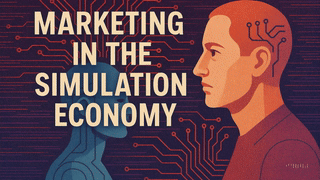Marketing in the Age of Simulation
Why Predictive Systems Demand Human-Centered Accountability
After reading “The False Intention Economy” by Katalin (Kati) Bártfai-Walcott, I started to envision what marketers would be doing in her illustration of the post-intention economy, and if things progress the way she details them, then I have to say to marketers everywhere; We Are Not Ready for What We’re Building.
The Simulation Economy: Where Predictions Replace People
Through citing many varied resources and research into this moment in time, Katalin explains we are shifting into what could be called a simulation economy—a system designed not around human decisions but around predicted ones. AI models interpret behavioral patterns, anticipate desires, and execute actions before a person ever speaks. In many platforms today, users don’t need to choose for things to happen on their behalf.
In this world, marketing stops being a practice of persuasion. It becomes a practice of preemption.
We don’t ask—we infer.
We don’t persuade—we predict.
We don’t wait—we act.
This changes the core function of marketing. Instead of speaking to people, we increasingly speak through models that simulate them. Engagement is optimized, not experienced. Loyalty is predicted, not earned.
Representation Without Representation
Perhaps the most profound shift is this: the rise of algorithmic proxies—digital shadows that increasingly act on our behalf.
These proxies:
Click for us
Shop for us
Curate content for us
Influence the ads we see
Shape how brands perceive “us”
But these digital twins are not neutral. They reflect historical behavior, not current intent. They often reinforce biases. And they operate without our explicit oversight.
In this system, marketing stops engaging real people and starts transacting with approximations of them. That means:
Authentic connection is deprioritized
Loyalty becomes a machine-readable pattern
Brand-building strategies get reduced to data-fitting exercises
Marketing’s New Role: From Storytelling to System Design
For decades, marketers have been storytellers—shaping narratives to inspire action. That role is fading. The marketer of the near future won't be crafting campaigns, but input vectors for machine learning models.
This new reality means:
Audience segmentation becomes agentic twin modeling—targeting behavioral proxies instead of people.
A/B testing becomes response optimization—fine-tuning predicted outcomes rather than testing expressed preferences.
Personalization becomes loop-closing—feeding algorithms that entrench existing patterns rather than enabling discovery.
The risk? We lose touch with the actual humans behind the models and make decisions that reinforce simulations rather than challenge them.
Consent at Scale: The Illusion of Agreement
Digital consent has always been a gray area. In a predictive marketing system, it becomes even murkier.
Most users don't read the terms.
Most consent flows are designed for speed, not understanding.
Opting out is often buried in friction.
Revoking permission is functionally impossible.
And yet, nearly every brand interaction is built on this foundation. We claim ethical integrity while working atop a system that quietly sidelines it.
If we are serious about accountability, we must stop asking only "Was consent collected?" and start asking "Was it informed, intentional, and revocable?"
What Marketers Must Do—Now
This isn’t a future scenario—it’s an infrastructure that’s already underway. If marketers want to preserve human will, trust, and long-term brand value, we must intervene at the design level.
Here’s what that looks like in practice:
1. Declare Intent Before Acting
Build systems that don’t preempt user behavior. Let users signal when they’re ready. Slow down the automation—especially where choice matters.
2. Redesign Consent for Real Control
Consent should be active, not passive. It must be inspectable, revocable, and context-specific. Systems should make it easy to change your mind.
3. Make Digital Twins Transparent and Editable
If we’re going to use behavioral proxies, users must be able to see them, understand them, and override them. Anything less undermines trust.
4. Embrace Friction Where It Counts
Deliberation isn't inefficiency—it's what makes autonomy real. Not every click needs to be frictionless. Create moments where people can reflect, reconsider, and re-assert control.
5. Audit the System, Not Just the Outcome
Performance metrics don’t tell the whole story. We need marketers who ask: How did this system make its decisions? Was that process fair, inclusive, and transparent?
Marketing Accountability in the Age of AI
This moment demands new leadership from marketers—not just in tactics but in values. Performance will always matter, but in this new age, ethics must become a metric.
That means fighting for:
Transparency in targeting logic
Respect for user ambiguity and unpredictability
Protection of autonomy and identity
Sustainable brand building over short-term optimization
If we don’t shape these systems, they will shape us. And if marketing loses its grounding in real human connection, we risk becoming irrelevant—even efficient, even profitable—but irrelevant all the same.
In the simulation economy, accountability won’t just be a best practice.
It will be the last line of defense for marketing with meaning.



This made me think about how easy it is to get caught up in looking successful, whether it’s in marketing, design, or even life. The danger is when the signal gets louder than the substance.
Hmmm, interesting.